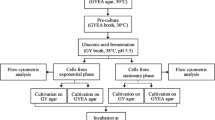Summary
Acidogenesis and solventogenesis byClostridium beijerinckii NRRL B-593 has been studied in batch growth, and in sucrose-limited chemostat and recycling fermentor growth. Cells grown in batch culture without pH control primarily produced either butyric and acetic acids, or these acids plus butanol, ethanol and isopropanol in ratios depending on the medium's content of reducing agent, calcium and iron. Cells in chemostat-culture at a mass doubling time (td) of 5.8 h produced primarily butyric and acetic acids at pH 6.8 and these acids plus butanol, ethanol and isopropanol at pH 4.8. Cells grown in a recycling fermentor (in which the td continuously increases) at pH 6.8 entered solventogenesis at a td of 43 h, producing primarily propanol, ethanol and butanol, along with butyric acid, but with greatly decreased production of acetic acid. Although “clostridial form” morphology, succeeded by sporulation, usually accompanied solventogenesis, the association was not invariant so that solventogenesis and sporogenesis can occur separately in this species.
Similar content being viewed by others
References
Arbige A, Chesbro W (1982)rel A and related loci are growth rate determinants forEscherichia coli in a recycling fermentor. J Gen Microbiol 128:693–703
Bahl H, Gottwald M, Kuhn A, Rale V, Andersch W, Gottschalk G (1986) Nutritional factors affecting the ratio of öolvents produced byClostridium acetobutylicum. Appl Environ Microbiol 52:169–172
Blanchard KC, MacDonald J (1935) Bacterial metabolism: reduction of propionaldehyde and of propionic acid byClostridium acetobutylicum. J Biol Chem 110:145–150
Chesbro W, Evans TE, Eifert R (1979) Very slow growth ofEscherichia coli. J Bacteriol 139:625–638
Fond O, Engrasser JM, Matta-El-Amouri G, Petitdemage H (1986) The acetone butanol fermentation on glucose and xylose. I. Regulation and kinetics in batch cultures. Biotechnol Bioeng 28:160–166
Forsberg CW, L Donaldson, LN Gibbins (1987) Metabolism of rhamnose and other sugars by strains ofClostridium acetobutylicum and otherClostridium species. Can J Microbiol 33:21–26
Freese E, Heinze J (1983) Metabolic and genetic control of bacterial sporulation. In: Hurst A, Gould GW (ed) The bacterial spore II. Acedemic Press, New York, pp 102–163
George HA, Chen JS (1983) Acidic conditions are not obligatory for onset of butanol formation byClostridium beijerinckii (synonym,C. butylicum). Appl Environ Microbiol 46:321–327
George HA, Johnson JL, Moore WE, Holdeman LV, Chen JS (1983) Acetone, isopropanol, and butanol production byClostridium beijerinckii (syn.Clostridium butylicum) andClostridium aurantibutyricum. Appl Environ Microbiol 45:1160–1163
Hansford GS, Humphrey AE (1966) The effect of equipment scale and degree of mixing on continuous fermentation yield at low dilution rates. Biotechnol Bioeng 8:85–96
Holt RA, Stephens GM, Morris JG (1984) Production of solvents byClostridium acetobutylicum cultures maintained at neutral pH. Appl Environ Microbiol 48:1166–1170
Jewell JB, Coutinho JB, Kropinski AM (1986) Bioconversion of propionic byClostridium acetobutylicum NRRL 527. Curr Microbiol 13:215–219
Jobses IML, Roels JA (1983) Experience with solvent production byClostridium beijerinckii in continuous culture. Biotechnol Bioeng 25:1187–1194
Jones DT, van der Westhuizen A, Long S, Allcock ER, Reid SJ, Woods DR (1982) Solvent production and morphological changes inClostridium acetobutylicum. Appl Microbiol Biotechnol 20:256–261
Long S, Jones DT, Woods DR (1984) Initiation of solvent production, clostridial stage, and endospore formation inClostridium acetobutylicum P262. Biotechnol Lett 6:529–534
Meinecke B, Bahl H, Gottschalk G (1984) Selection of an asporogenous strain ofClostridium acetobutylicum in continuous culture under phosphate limitation. Appl Environ Microbiol 48:1064–1065
Neijssel O, Tempest D (1979) The physiology of metabolite overproduction. In: Bull AT, Ellwood DC, Ratledge C (eds) Microbial Technology: current state, future prospects. Cambridge University Press, New York
O'Toole DK (1983) Weighing technique for determining bacterial dry mass based on rate of moisture uptake. Appl Environ Microbiol 46:506–508
Reysenbach AL, Ravenscroft N, Long S, Jones DT, Woods DR (1986) Characterization, biosynthesis, and regulation of granulose inClostridium acetobutylicum. Appl Environ Microbiol 52:185–190
Roos JW, McLaughlin JK, Papoutsakis ET (1985) The effect of pH on nitrogen supply, cell lysis, and solvent production in fermentations ofClostridium acetobutylicum. Biotechnol Bioeng 27:681–694
Speakman HB (1920) Biochemistry of the acetone and butyl alcohol fermentation of starch byBacillus granulobacter pectinovorum. J Biol Chem 41:319–343
Stouthamer AH, van Verseveldt HW (1985) Stoichiometry of microbial growth. In: Moo-Young M (ed) Comprehensive Biotechnology 1. The principles of biotechnology. Pergamon Press, Oxford, pp 215–238
Terracciano JS, Kashket ER (1986) Intracellular conditions required for initiation of solvent production byClostridium acetobutylicum. Appl Environ Microbiol 52:86–91
Van Verseveldt HW, Arbige A, Chesbro W (1984a) Continuous culture of bacteria with biomass retention. Trends in Biotechnol 2:8–12
Van Verseveldt HW, Chesbro WR, Braster M, Stouthamer AH (1984b) Eubacteria have 3 growth modes keyed to nutrient flow. Arch Microbiol 137:176:184
Votruba J, Volesky B, Yerushalmi L (1986) Mathematical model of a batch acetone-butanol fermentation. Biotechnol Bioeng 28:247–255
Author information
Authors and Affiliations
Rights and permissions
About this article
Cite this article
Ahmed, I., Ross, R.A., Mathur, V.K. et al. Growth rate dependence of solventogenesis and solvents produced byClostridium beijerinckii . Appl Microbiol Biotechnol 28, 182–187 (1988). https://doi.org/10.1007/BF00694309
Received:
Accepted:
Issue Date:
DOI: https://doi.org/10.1007/BF00694309




